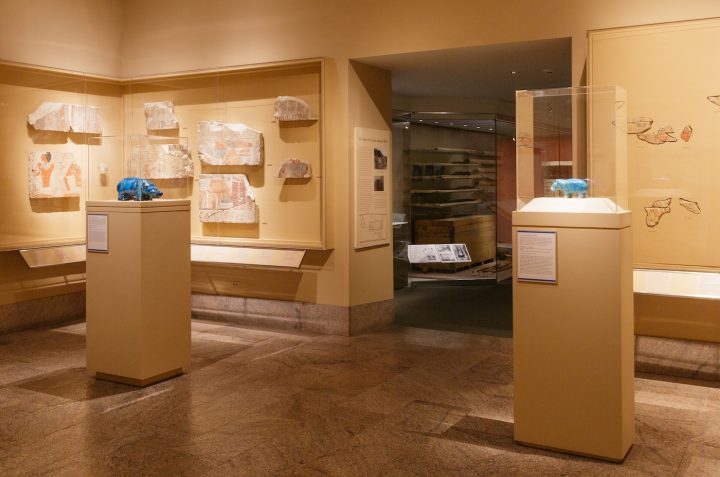https://hyperallergic.com/411777/celebrating-100-years-of-william-the-hippo-met-museum-mascot/
Celebrating 100 Years of William the Hippo, the Met Museum's Mascot
The Met honors one of its icons, William the hippo, with a redisplay and dedicated series of events.

In 1931, an article appeared in the now defunct British weekly Punch that described the mystique of one small, faience hippo — the ancient Egyptian statuette, decorated with lotus flowers, that is today among the most recognized objects at the Metropolitan Museum of Art. Its author, one Captain H. M. Raleigh, detailed how a framed print of the hippo in his drawing room had an effect so powerful on him and his family that they considered the hippo an oracle of sorts: a bright blue beast they consulted before making any major decisions.
"He is described on the back of the frame as 'Hippopotamus with Lotus Flowers, Buds and Leaves, XII. Dynasty (about 1950 B.C.), Series VII., Number 1, Egyptian Faience'; but to us he is simply William," Raleigh wrote. "We have come to love and revere him with an intensity bordering on the pagan."

Punch is a satirical magazine, and Raleigh most likely a false byline. But "William," the name seemingly pulled out of nowhere, stuck. Soon after the article was published, the Met circulated a copy through an issue of its quarterly publication, Bulletin, and the museum has since referred to the ancient Egyptian creature by the old Norman name. It's even shown on its display label, printed as "Hippopotamus (William)."
William is now famous as the institution's unofficial mascot, appearing on a variety of its merchandise — tote bags, ties, erasers, and more. This year marks the 100th anniversary of the museum's acquisition of William, and the Met is celebrating the occasion with a small, eight-month-long redisplay. This weekend, it will produce a series of related events, featuring curator talks on ancient Egyptian artworks and special William-themed cookies and cocktails. William also took a trip to the Met's conservation lab last month, where researchers examined and x-rayed the hippo to better understand how he was manufactured from faience paste.
Made around 1961–1878 BCE and originally placed in the tomb chapel of "The Steward, Senbi," William saw light again in 1910. He ended up at the Met just seven years later, donated by philanthropist Edward Harkness. William is actually one of about a dozen faience hippos the museum owns, but the sole anthropomorphized one.
"The quality of this particular statuette and its excellent state of preservation make 'William' the best example of this type of object in our collection, and he is the faience hippo statuette that visitors react to most strongly," Isabel Stünkel, the associate curator of the Department of Egyptian Art told Hyperallergic. "'William' is and always has been very popular with museum visitors, which is why we often refer to him as an 'unofficial mascot.'"

The ongoing exhibition, Conversation between Two Hippos, is straightforward, placing William in a display case opposite one holding a larger ceramic hippo made by Carl Walters in 1936 that the museum recently acquired. Walters's work, simply named "Hippopotamus," shines a brilliant turquoise because of a glaze Walters developed in the early 1920s known as "Walters blue." Like William, its surface is also decorated, only with leaflike and scroll motifs.
"Carl Walters visited The Met and was inspired by Egyptian art, in particular by the color blue of Egyptian faience,"Stünkel said. "The installation allows our visitors to see an art work that inspired Carl Walters together with this artist's own creation. The resulting conversation of these two hippos depends much on the viewer — is it about size, color, and shape? Or is it about place and time?"
If we heed the words of Raleigh, whoever they were, Walters's hippo will have to seriously assert its presence as it comes head-to-head with its smaller, evocative relative from Egypt. As the mystery author wrote:
If ever animal was in tune with the infinite, William is. His shape is irregular and dumpy, his flanks are decorated with the outline of the lotus flowers, buds and leaves, the pottery has chipped off his near fore-foot, giving the impression, at all events in the colour-print, of a grey woollen sock bursting through a boot … but it is impossible to look at him for long without a feeling of awe and a realisation of the vastness of eternity.

Conversation between Two Hippos continues through April 1, 2018 at the Metropolitan Museum of Art (1000 5th Avenue, Upper East Side, Manhattan)
-- Sent from my Linux system.
No comments:
Post a Comment